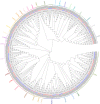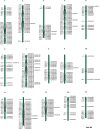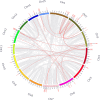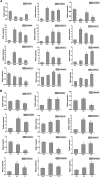Genome-wide analysis of the P450 gene family in tea plant (Camellia sinensis) reveals functional diversity in abiotic stress
- PMID: 37697232
- PMCID: PMC10494425
- DOI: 10.1186/s12864-023-09619-4
Genome-wide analysis of the P450 gene family in tea plant (Camellia sinensis) reveals functional diversity in abiotic stress
Abstract
Background: Cytochrome P450 (Cytochrome P450s) genes are involved in the catalysis of various reactions, including growth, development, and secondary metabolite biosynthetic pathways. However, little is known about the characteristics and functions of the P450 gene family in Camellia sinensis (C. sinensis).
Results: To reveal the mechanisms of tea plant P450s coping with abiotic stresses, analyses of the tea plant P450 gene family were conducted using bioinformatics-based methods. In total, 273 putative P450 genes were identified from the genome database of C. sinensis. The results showed that P450s were well-balanced across the chromosomes I to XV of entire genome, with amino acid lengths of 268-612 aa, molecular weights of 30.95-68.5 kDa, and isoelectric points of 4.93-10.17. Phylogenetic analysis divided CsP450s into 34 subfamilies, of which CYP71 was the most abundant. The predicted subcellular localization results showed that P450 was distributed in a variety of organelles, with chloroplasts, plasma membrane,,and cytoplasm localized more frequently. The promoter region of CsP450s contained various cis-acting elements related to phytohormones and stress responses. In addition, ten conserved motifs (Motif1-Motif10) were identified in the CsP450 family proteins, with 27 genes lacking introns and only one exon. The results of genome large segment duplication showed that there were 37 pairs of genes with tandem duplication. Interaction network analysis showed that CsP450 could interact with multiple types of target genes, and there are protein interactions within the family. Tissue expression analysis showed that P450 was highly expressed in roots and stems. Moreover, qPCR analysis of the relative expression level of the gene under drought and cold stress correlated with the sequencing results.
Conclusions: This study lays the foundation for resolving the classification and functional study of P450 family genes and provides a reference for the molecular breeding of C. sinensis.
Keywords: Camellia sinensis; Gene expression; P450 gene family; Promoter; Synteny analysis.
© 2023. BioMed Central Ltd., part of Springer Nature.
Conflict of interest statement
The authors declare no competing interests.
Figures










References
-
- Mizutani M, Ohta D. Diversification of P450 Genes During Land Plant Evolution. Annu Rev Plant Biol. 2010;61:291–315. - PubMed
-
- Mizutani M. Impacts of Diversification of Cytochrome P450 on Plant Metabolism. Biol Pharm Bull. 2012;35:824–832. - PubMed
-
- Chapple C. MOLECULAR-GENETIC ANALYSIS OF PLANT CYTOCHROME P450-DEPENDENT MONOOXYGENASES. Annu Rev Plant Physiol Plant Mol Biol. 1998;49:311–343. - PubMed
MeSH terms
Substances
LinkOut - more resources
Full Text Sources

